At ValidExamDumps, we consistently monitor updates to the Arcitura Education C90.03 exam questions by Arcitura Education. Whenever our team identifies changes in the exam questions,exam objectives, exam focus areas or in exam requirements, We immediately update our exam questions for both PDF and online practice exams. This commitment ensures our customers always have access to the most current and accurate questions. By preparing with these actual questions, our customers can successfully pass the Arcitura Education Cloud Technology Lab exam on their first attempt without needing additional materials or study guides.
Other certification materials providers often include outdated or removed questions by Arcitura Education in their Arcitura Education C90.03 exam. These outdated questions lead to customers failing their Arcitura Education Cloud Technology Lab exam. In contrast, we ensure our questions bank includes only precise and up-to-date questions, guaranteeing their presence in your actual exam. Our main priority is your success in the Arcitura Education C90.03 exam, not profiting from selling obsolete exam questions in PDF or Online Practice Test.
A cloud consumer is interested in leasing cloud-based virtual servers. It compares the virtual servers offered by Cloud Provider X and Cloud Provider Y. Cloud X (owned by Cloud Provider X) and Cloud Y (owned by Cloud Provider Y) both provide shared physical servers that host multiple virtual servers for other cloud consumers. The virtual servers on Cloud X are accessed directly, whereas the virtual servers on Cloud Y are accessed via an automated scaling listener. On Cloud X, virtual servers are pre-configured to support a specific amount of concurrent cloud service consumers. When this threshold is exceeded, cloud service consumer requests are rejected. Due to the use of the automated scaling listener, virtual servers on Cloud Y can provide a greater level of elasticity. The hourly cost to the cloud consumer to use a virtual server on Cloud X is half that of the cost to use a virtual server on Cloud Y. Within a one month period, Cloud Provider X bases its hourly charge on the maximum number of virtual servers used. Within a one month period, Cloud Provider Y bases its hourly charges on actual virtual server usage. Cloud Provider Y charges $20 for each hour that a cloud consumer uses a virtual server.
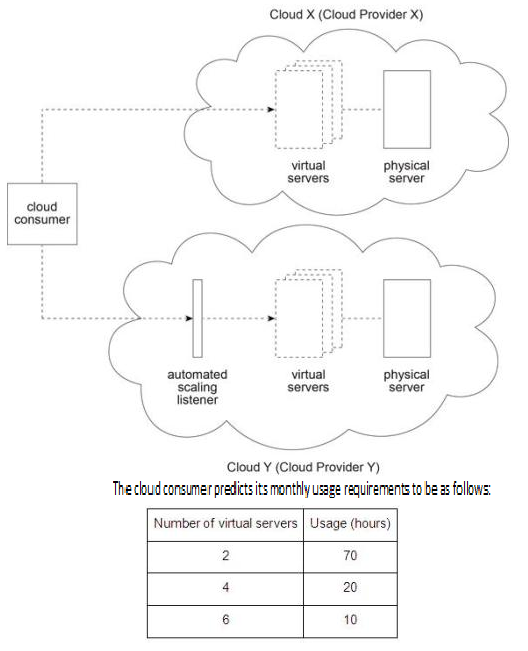
The cloud consumer is required choose the cloud provider with the lowest on-going cost based on its predicted usage. Which of the following statements accurately calculates the on-going usage costs of Cloud Providers X and Y and correctly states the cloud provider that the cloud consumer must choose?
Cloud Service A is being made available on public Cloud X by Cloud Provider X via the SaaS delivery model. Cloud Service A is hosted by Physical Server A that also hosts cloud services being used by different cloud service consumers (and owned by different cloud service owners). Cloud Service Consumers A and B access Cloud Service A on a regular basis and Physical Server A has been able to accommodate the resulting usage load After reviewing the implementation environment for Cloud Service A . Cloud Provider X determines it needs to enhance the ubiquitous access and multi-tenancy characteristics within this part of Cloud X.
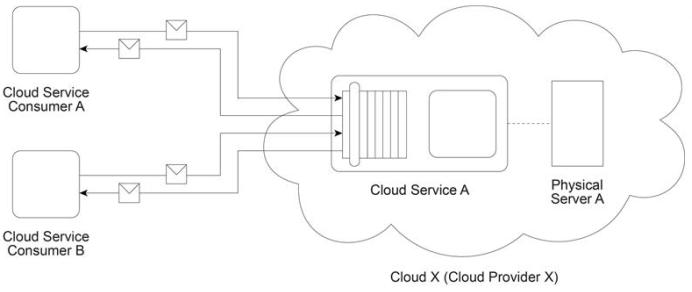
Which of the following statements accurately describes a solution that fulfills all of these requirements?
Cloud Provider Y owns Cloud Y, which provides a set of cloud services, virtual servers and one physical server. Cloud Services A and B are hosted on Virtual Server A, which is hosted by Physical Server A . Physical Server A also hosts Virtual Server B, which hosts redundant implementations of Cloud Services A and B for load balancing purposes. Cloud Service Consumer A is accessing Cloud Service A located on Virtual Server A . Cloud Service Consumer B is accessing Cloud Service B located on Virtual Server B . Cloud Service Consumers A and B are both owned by Cloud Consumer X. Cloud Consumer X has recently complained that Cloud Services A and B have become less available than what is guaranteed in their service level agreements (SLAs). Cloud Provider Y launches an investigation that reveals that Virtual Servers A and B have been subjected to denial of service attacks. This is confirmed as the cause of the decline in the availability of Cloud Services A and B.
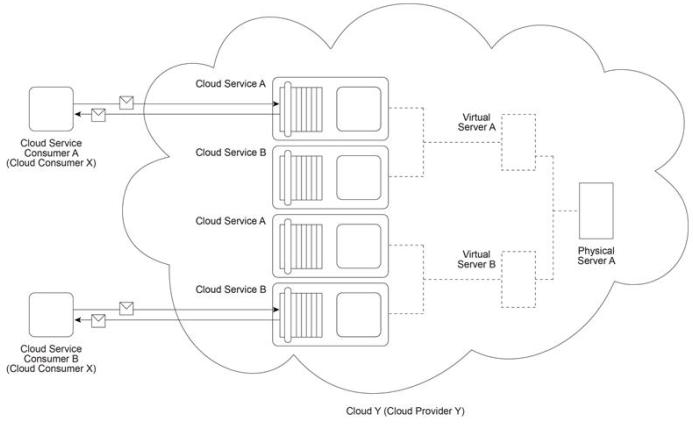
Which of the following statements describes a solution that can increase the availability of Cloud Services A and B?
Cloud Provider X (which owns Cloud X) deploys two physical servers (Physical Servers A and B) and two databases (Databases A and B). Virtual Servers A and B are hosted by Physical Server A and Ready-Made Environments A and B are hosted by Virtual Server B . Virtual Servers C and D are hosted by Physical Server B . Cloud Service Consumer A regularly accesses Virtual Server D in order to test and deploy a new cloud service that was developed on-premise by the cloud consumer organization operating Cloud Service Consumer A . Cloud Service Consumer B (operated by a different cloud consumer organization) has been regularly accessing Ready-Made Environment A in order to develop and deploy a different new cloud service. The cloud consumer organizations that own and operate Cloud Service Consumers A and B will soon be ready to launch their respective cloud services for use by their customers. Both cloud consumer organizations are concerned that Cloud X does not provide sufficient security and they demand that Cloud Provider X take the necessary steps to mitigate the denial of service, insufficient authorization and overlapping trust boundaries security threats.
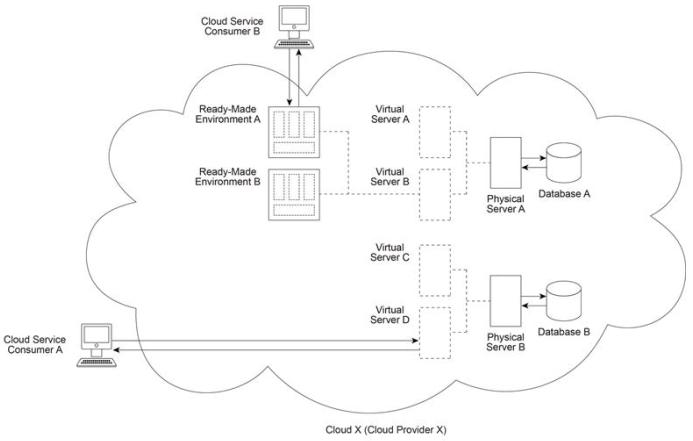
Which of the following statements accurately describes the cloud delivery models used now by the cloud service consumers and in the future by their customers - and - further describes a solution that fulfills the identified security requirements by implementing a single cloud security mechanism?
Cloud Provider X has deployed a virtualization environment in Cloud X comprised of Physical Server A hosting Virtual Servers A and B. Cloud Provider X implements Cloud Service A on Virtual Server A and makes it available to Cloud Service Consumer A, which interacts with Cloud Service A by sending and receiving messages (1, 2). Cloud Provider Y has deployed a virtualization environment comprised of Physical Server B hosting Virtual Servers C and D. Virtual Server C is made available to Cloud Service Consumer B, which interacts with Virtual Server C (3,4) in order to prepare for the deployment of a new cloud service that will be used internally by Cloud Provider Y to process data obtained from Cloud Service A .
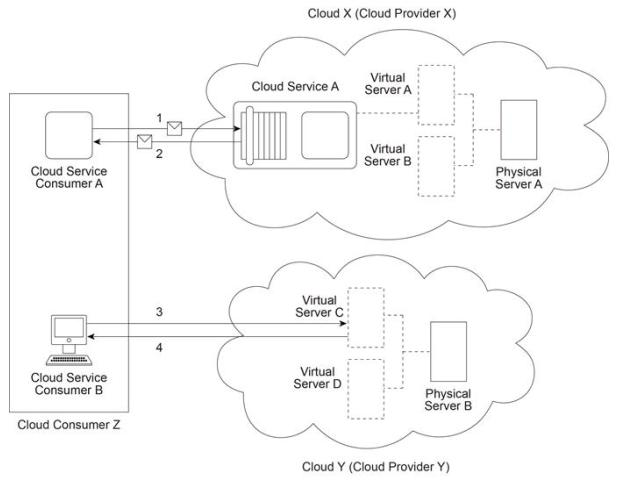
Cloud Consumer Z and Cloud Provider X belong to the same organization. Cloud Provider Y is a third-party organization. Which of the following statements provides a valid scenario that accurately describes the involvement of cloud deployment models, cloud delivery models, roles and/or boundaries? (Note that the correct answer represents one of multiple valid scenarios that can exist.)